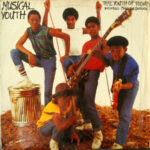 “Take On Me” is one of the most iconic songs of the 1980s, achieving global fame not just through its memorable melody and upbeat rhythm, but also through its groundbreaking music video. Released in 1985 by the Norwegian synthpop band A-ha, the song became a worldwide hit and remains a quintessential anthem of the era. With its instantly recognizable falsetto vocals, catchy synthesizer riff, and innovative music video, “Take On Me” became a defining track of the 80s, capturing the essence of the era’s optimism, technological advancement, and pop culture revolution.
“Take On Me” is one of the most iconic songs of the 1980s, achieving global fame not just through its memorable melody and upbeat rhythm, but also through its groundbreaking music video. Released in 1985 by the Norwegian synthpop band A-ha, the song became a worldwide hit and remains a quintessential anthem of the era. With its instantly recognizable falsetto vocals, catchy synthesizer riff, and innovative music video, “Take On Me” became a defining track of the 80s, capturing the essence of the era’s optimism, technological advancement, and pop culture revolution.
The song has stood the test of time and continues to resonate with new generations of listeners, making it a pop culture mainstay. In this article, we will explore the making of “Take On Me,” its cultural impact, its significance in the context of 1980s music, and its enduring legacy in the music industry.
A-Ha: The Formation and Early Years
A-ha, formed in Oslo, Norway, in 1982, initially consisted of three members: Morten Harket (vocals), Magne Furuholmen (keyboards), and Pål Waaktaar-Savoy (guitar). The band was created in an era dominated by the explosion of new wave, synthpop, and electronic music, genres that often utilized synthesizers, drum machines, and electronic effects to create futuristic, catchy, and energetic sounds. A-ha was part of the new wave movement that swept across Europe, and they quickly became known for their distinctive sound and the unique, soaring vocal style of Harket.
Before their breakthrough with “Take On Me,” A-ha struggled to gain recognition outside of Norway. They had a series of unsuccessful singles, and it wasn’t until they signed with Warner Bros. Records and reworked “Take On Me” that their fortunes would change.
The Creation of “Take On Me”
“Take On Me” was written by the band members themselves, with lyrics by lead singer Morten Harket and music composed by Pål Waaktaar-Savoy. The song underwent multiple iterations before it became the hit version known today. Its creation involved a lengthy and experimental process.
The first version of “Take On Me” was recorded in 1983, but it lacked the polished sound and structure that would eventually propel it to international fame. The band re-recorded the song several times, refining it until it had the electrifying pop appeal that would make it stand out in a crowded music scene. The final version, released in 1985, featured a unique mix of synthpop, danceable beats, and catchy hooks that helped it transcend the genre.
Lyrically, “Take On Me” tells the story of a romantic relationship and the desire for escape from the mundane. The lyrics speak of love and longing, with the protagonist urging their lover to take a chance and join them in a life of adventure. The message of the song reflects themes of optimism and the yearning for freedom that were central to the 1980s cultural zeitgeist.
The song’s lyrics are simple yet powerful, with the chorus (“Take on me, take me on, I’ll be gone in a day or two”) encapsulating the sense of fleeting love and uncertainty. The emotional intensity of the song is heightened by Harket’s soaring falsetto, which became one of the most distinctive features of the track.
The Impact of “Take On Me”
Upon its release in 1985, “Take On Me” immediately stood out from other songs in the pop music landscape. Its mix of catchy, upbeat melodies and emotionally charged lyrics resonated with a wide audience, and it quickly became a hit in Norway and Europe. However, the song’s major breakthrough came when it was released in the United States.
Initially, “Take On Me” failed to make a significant impact on the U.S. charts when it was first released in 1984. However, in 1985, the band re-released the song with a more polished production, and this time it was accompanied by an innovative music video that would go on to make history.
The Revolutionary Music Video
One of the defining features of “Take On Me” is its groundbreaking music video, which revolutionized the way music videos were produced and consumed. Directed by Steve Barron, the video was a groundbreaking blend of animation, live-action footage, and special effects, which was unprecedented at the time.
The video tells a love story between a woman (played by actress Bunty Bailey) and a cartoon version of Morten Harket, created through rotoscoping, a technique where animators trace over live-action footage to create animated characters. The video’s narrative features a fantastical and surreal romance in which the woman is drawn into a comic book world through the pages of a book, where she meets Harket’s animated character. The video’s innovative use of animation and live-action combined with the song’s upbeat tempo and emotional depth, creating a unique cinematic experience that stood out in the world of 1980s music videos.
The visual style of the video became iconic, with its mix of hand-drawn animation and live-action sequences becoming a defining feature of 1980s pop culture. The combination of cutting-edge technology with a heartfelt love story set “Take On Me” apart from other videos at the time, making it a visual and auditory masterpiece.
The video’s success helped propel the song to new heights. “Take On Me” peaked at number one on the Billboard Hot 100 chart in the United States in October 1985, becoming A-ha’s most successful single. The success of the song and video helped A-ha gain international recognition and solidified their place in the music world.
“Take On Me” and the 1980s Music Scene
“Take On Me” was not just a commercial success but also a critical one, with the song and its music video often hailed as one of the greatest pop music moments of the 1980s. The 1980s was a decade defined by innovation in pop music, as artists embraced new technologies, synthesizers, and the rapidly evolving world of music videos. The explosion of cable television networks like MTV helped to elevate music videos to the forefront of the music industry, and A-ha’s “Take On Me” was a perfect example of how music videos could enhance a song’s appeal and reach.
The song’s success marked a high point for the synthpop genre, which was characterized by the use of synthesizers and electronic elements to create catchy, danceable music. A-ha was one of the leading acts in this genre, and “Take On Me” was a shining example of the genre’s potential to produce pop music with both emotional depth and technological sophistication.
The song also captured the youthful energy and optimism of the 1980s, a time of economic growth, cultural change, and technological innovation. The 1980s were marked by a sense of excitement and possibility, and “Take On Me” encapsulated this spirit through its infectious melody and optimistic lyrics. The track became an anthem for a generation that embraced new technologies, fashion, and music, and its popularity was bolstered by its ability to appeal to both mainstream audiences and alternative subcultures.
A-Ha’s Legacy and Continued Relevance
“Take On Me” remains A-ha’s most successful song to date, and its impact continues to be felt long after its release. The song’s distinctive sound and innovative music video have ensured its place in music history, and it continues to be played on radio stations and in clubs around the world. Over the years, “Take On Me” has been covered by numerous artists, further cementing its status as a timeless pop classic.
Despite their early success, A-ha never fully replicated the commercial impact of “Take On Me” with subsequent releases. However, the song’s legacy has helped keep the band relevant in the years that followed. A-ha has continued to tour and record new music, with “Take On Me” remaining a staple of their live performances. The song’s enduring popularity has introduced it to new generations of listeners, and it remains a defining track of the 1980s.
In addition to its musical legacy, “Take On Me” has been featured in numerous films, TV shows, and commercials, further embedding it into popular culture. Its catchy melody and distinctive sound have made it a go-to song for directors and advertisers looking to evoke the nostalgia and energy of the 1980s.
Conclusion
“Take On Me” by A-ha is much more than just a pop song; it is a cultural landmark that defined a decade and left a lasting impact on music history. With its infectious melody, soaring vocals, and groundbreaking music video, the song remains a timeless classic that continues to captivate listeners of all ages. Whether through its innovative use of animation or its emotional resonance, “Take On Me” stands as a testament to the creativity and optimism of the 1980s, and it will continue to be remembered as one of the defining songs of the era.
A-ha’s journey from a relatively unknown Norwegian band to international superstars is a story of perseverance, artistic innovation, and the power of music to transcend cultural boundaries. “Take On Me” remains an enduring symbol of their talent, and its legacy will continue to inspire and resonate with fans around the world for generations to come.
This post has already been read 170 times!









